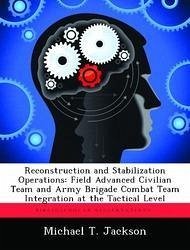On 7 December 2005, President Bush signed the National Security Presidential Directive (NSPD) 44, Management of Interagency Efforts Concerning Reconstruction and Stabilization. NSPD 44 established the State Department Office of the Coordinator for Reconstruction and Stabilization (S/CRS) as the lead agency for United States Government reconstruction and stabilization operations. Within the interagency framework, the S/CRS has roles at each level of war (strategic, operational, and tactical) and integrates with the Department of Defense at every echelon. At the tactical level the S/CRS will coordinate activities with Army brigade combat teams (BCTs) through Field Advanced Civilian Teams (FACTs). This thesis uses qualitative analysis to determine what doctrinal, organizational, and training factors will enable or constrain effective integration during future operations. The findings indicate that doctrinally, FACTs approach reconstruction and stabilization operations more conceptually while BCTs are highly procedural. FACTs also train at an individual level and rely on a more centralized ad-hoc organizational structure while BCTs train and operate as decentralized units. Further, each organization has its own set of terminology. If understood these differences can benefit the whole-of-government approach to reconstruction and stabilization operations; if they are not understood, they can constrain progress through confusion, redundancy, and a lack of unity of effort.
Bitte wählen Sie Ihr Anliegen aus.
Rechnungen
Retourenschein anfordern
Bestellstatus
Storno









